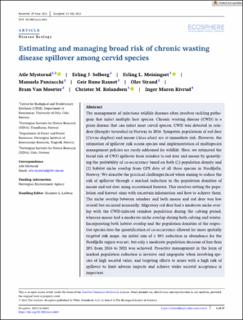| dc.contributor.author | Mysterud, Atle | |
| dc.contributor.author | Solberg, Erling Johan | |
| dc.contributor.author | Meisingset, Erling L. | |
| dc.contributor.author | Panzacchi, Manuela | |
| dc.contributor.author | Rauset, Geir Rune | |
| dc.contributor.author | Strand, Olav | |
| dc.contributor.author | Van Moorter, Bram | |
| dc.contributor.author | Rolandsen, Christer Moe | |
| dc.contributor.author | Rivrud, Inger Maren | |
| dc.coverage.spatial | Norway | en_US |
| dc.date.accessioned | 2023-09-26T11:52:30Z | |
| dc.date.available | 2023-09-26T11:52:30Z | |
| dc.date.created | 2023-09-18T13:18:38Z | |
| dc.date.issued | 2023 | |
| dc.identifier.issn | 2150-8925 | |
| dc.identifier.uri | https://hdl.handle.net/11250/3092061 | |
| dc.description.abstract | The management of infectious wildlife diseases often involves tackling pathogens that infect multiple host species. Chronic wasting disease (CWD) is a prion disease that can infect most cervid species. CWD was detected in reindeer (Rangifer tarandus) in Norway in 2016. Sympatric populations of red deer (Cervus elaphus) and moose (Alces alces) are at immediate risk. However, the estimation of spillover risk across species and implementation of multispecies management policies are rarely addressed for wildlife. Here, we estimated the broad risk of CWD spillover from reindeer to red deer and moose by quantifying the probability of co-occurrence based on both (1) population density and (2) habitat niche overlap from GPS data of all three species in Nordfjella, Norway. We describe the practical challenges faced when aiming to reduce the risk of spillover through a marked reduction in the population densities of moose and red deer using recreational hunters. This involves setting the population and harvest aims with uncertain information and how to achieve them. The niche overlap between reindeer and both moose and red deer was low overall but occurred seasonally. Migratory red deer had a moderate niche overlap with the CWD-infected reindeer population during the calving period, whereas moose had a moderate niche overlap during both calving and winter. Incorporating both habitat overlap and the population densities of the respective species into the quantification of co-occurrence allowed for more spatially targeted risk maps. An initial aim of a 50% reduction in abundance for the Nordfjella region was set, but only a moderate population decrease of less than 20% from 2016 to 2021 was achieved. Proactive management in the form of marked population reduction is invasive and unpopular when involving species of high societal value, and targeting efforts to zones with a high risk of spillover to limit adverse impacts and achieve wider societal acceptance is important. disease management, host range, moose, multihost pathogens, niche overlap, Norway, population estimation, red deer, reindeer | en_US |
| dc.language.iso | eng | en_US |
| dc.rights | Navngivelse 4.0 Internasjonal | * |
| dc.rights.uri | http://creativecommons.org/licenses/by/4.0/deed.no | * |
| dc.subject | disease management | en_US |
| dc.subject | host range | en_US |
| dc.subject | moose | en_US |
| dc.subject | multihost pathogens | en_US |
| dc.subject | niche overlap | en_US |
| dc.subject | Norway | en_US |
| dc.subject | population estimation | en_US |
| dc.subject | red deer | en_US |
| dc.subject | reindeer | en_US |
| dc.title | Estimating and managing broad risk of chronic wasting disease spillover among cervid species | en_US |
| dc.title.alternative | Estimating and managing broad risk of chronic wasting disease spillover among cervid species | en_US |
| dc.type | Peer reviewed | en_US |
| dc.type | Journal article | en_US |
| dc.description.version | publishedVersion | en_US |
| dc.rights.holder | © 2023 The Authors | en_US |
| dc.subject.nsi | VDP::Zoologiske og botaniske fag: 480 | en_US |
| dc.subject.nsi | VDP::Zoology and botany: 480 | en_US |
| dc.source.volume | 14 | en_US |
| dc.source.journal | Ecosphere | en_US |
| dc.identifier.doi | 10.1002/ecs2.4663 | |
| dc.identifier.cristin | 2176046 | |
| dc.relation.project | Andre: Norwegian Environment Agency | en_US |
| dc.relation.project | Miljødirektoratet: “Red deer in Nordfjella” | en_US |
| dc.relation.project | Miljødirektoratet: “Population estimation as a basis for CWDmanagement” | en_US |
| dc.source.articlenumber | e4663 | en_US |
| cristin.ispublished | true | |
| cristin.fulltext | original | |
| cristin.qualitycode | 1 | |

